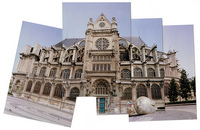British officials push modernism, call traditional architecture “pastiche”
PedShed‘s Laurence Aurbach sent over this great article in the UK’s Building magazine about “pastiche.” Apparently, people in Britain are much more hostile to traditional buildings than here in the ‘States’, with many towns adopting laws saying that “[New building] proposals that provide a pastiche … should be discouraged”, and “someone senior in English Heritage [a UK preservation group] announces that there’s ‘no contest’ between ‘good modern design and pastiche.’”
Robert Adam, the article’s author, writes what seems blindly obvious to most of us yet eludes some in the architectural profession:
In the dictionary, pastiche is “a composition made up of bits of other works or imitations of another’s style”. If this sounds bad, why? Sometime in the 20th century we got the strange idea that for art to be modern it has to be unlike anything done before. This is, of course, ridiculous. All art is based on ideas, influences and bits from other artists.
[In architecture], avoiding “imitation of another’s style” would mean that you couldn’t do something good because someone had already done it. This would not only be impossible; it would be stupid. You might just avoid being condemned as a pasticheur if you do a perfect copy, but try and be creative with tradition and your work will be consigned to a special dustbin. Except for a few periods, such as neoclassicism, architects of the past didn’t make replicas. They got their inspiration from different parts of history, mixed them up with ideas around at the time and made them into something new.
On this side of the pond, Globe columnist Yvonne Abraham’s criticism of the 350 Boyston St proposal sounds a lot like these pastiche-crusading Brits. I don’t particularly love that building, but react so negatively to calling anything a “generic genuflection to 19th-century architecture” as if incorporating any elements that worked in the 19th century is an architectural sin.
Adam continues:
“Pastiche” has just become a dumb shorthand that says “traditional architecture is bad” and “to be modern you have to keep reinventing the wheel”. But when the government announce that they will be “giving good design the same status as sustainability” how will the bureaucrats interpret something as woolly as this? The bigots have already given them the tools.
At the recent panel on modernism Theodore Prudon of US DOCOMOMO said that Americans participate much more in preservation, while Europeans tend to leave the decisions to experts and government officials. It sounds like the backlash against modernism has progressed much farther on this side of the Atlantic. Hooray for the American democratic spirit.

